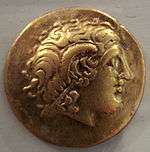Cenomani
The Cenomani or Aulerci Cenomani were a Celtic people, a branch of the Aulerci in Gallia Celtica, whose territory corresponded generally to Maine in the modern départment of Sarthe, west of the Carnutes between the Seine and the Loire. Their chief town was Vindinum or Suindinum (corrupted into 'Subdinnum'), afterwards Civitas Cenomanorum (whence Le Mans, and much later the Cenomanian geological age) and later Cenomani as in the Notitia Dignitatum, the original name of the town, as usual in the case of Gallic cities, being replaced by that of the people. According to Caesar (Bell. Gall. vii.75.3), they assisted Vercingetorix in the great rising (52 BC) with a force of 5000 men. Under Augustus they formed a civitas stipendiaria (Roman tributary town) of Gallia Lugdunensis, and in the 4th century part of Gallia Lugdunensis III.


Name
They are mentioned as Aulercos and Aulercis, Cenomanis totidem [all the same] by Caesar (mid-1st c. BC),[1] as Aulerci .... Cenomani by Pliny (1st c. AD),[2] as Au̓lírkioioi̔ oi̔ Kenománnoi (Αὐλίρκιοιοἱ οἱ Κενομάννοι) by Ptolemy (2nd c. AD),[3] and as Ceromannos in the Notitia Dignitatum (5th c. AD).[4][5]
The meaning of the name Cenomani is uncertain. The prefix stems from Gaulish ceno-, which could have meant 'far, long', and the second element may derive from manos ('good') or from *meih₁- ('to go').[6] Pierre-Yves Lambert has interpreted Aulerci as 'far from their track', stemming from the prefix au- ('out of, from') attached to the Gaulish root lergo- ('trace'), ultimately from Proto-Celtic *lorgo- ('trace'; compare with Middle Irish lorg, Old Breton lerg).[7]
The city of Le Mans, attested as Ceromannos ca. 400 AD (Cenomannis in 1101, *Cemans, then Le Mans from the 12th c.), and the Maine region, attested as in Cinomanico in the 6th c. AD (in pago Celmanico in 765, *Cemaine, then Le Maine from the 12th c.), are named after the Gallic tribe.[8]
Cisalpine Cenomani
There was another people called Cenomani that held extensive territory in Cisalpine Gaul; however, there is disagreement whether they are one and the same people. The orthography and the quantity of the penultimate vowel of Cenomani have given rise to discussion. According to Arbois de Jubainville, the Cenomni of Italy are not identical with the Cehomni (or Cenomanni) of Gaul. In the case of the latter, the survival of the syllable man in "Le Mans" is due to the stress laid on the vowel; had the vowel been short and unaccented, it would have disappeared. In Italy, Cenomani is the name of a people; in Gaul, merely a surname of the Aulerci. William Smith adopts the difference, placing the peoples in two separate articles in his Dictionary of Greek and Roman Geography. On the other hand, if the tradition recorded by Cato (in Pliny, Nat. Hist. iii. 19. s. 23) is true, that the Cenomani formed a settlement near Massilia (modern Marseille), among the Volcae, this could indicate a route that the Cenomani took to Cisalpine Gaul in Italy. According to Livy, the Cenomani of Cisalpine Gaul arrived after the expedition of Bellovesus, led by Helitovius, and are credited with the foundation of Brixia, or Brescia, and Verona.
References
- Caesar. Commentarii de Bello Gallico, 2:34; 7:75:3
- Pliny. Naturalis Historia, 4:107
- Ptolemy. Geōgraphikḕ Hyphḗgēsis, 2:8:8
- Notitia Dignitatum. oc 42, 35
- Falileyev 2010, p. entries 3030; 2249b.
- Delamarre 2003, pp. 114, 215.
- Delamarre 2003, p. 199.
- Nègre 1990, p. 153.
Bibliography
- Delamarre, Xavier (2003). Dictionnaire de la langue gauloise: Une approche linguistique du vieux-celtique continental (in French). Errance. ISBN 9782877723695.CS1 maint: ref=harv (link)
- Falileyev, Alexander (2010). Dictionary of Continental Celtic Place-names: A Celtic Companion to the Barrington Atlas of the Greek and Roman World. CMCS. ISBN 978-0955718236.
- Nègre, Ernest (1990). Toponymie générale de la France (in French). Librairie Droz. ISBN 978-2-600-02883-7.CS1 maint: ref=harv (link)


